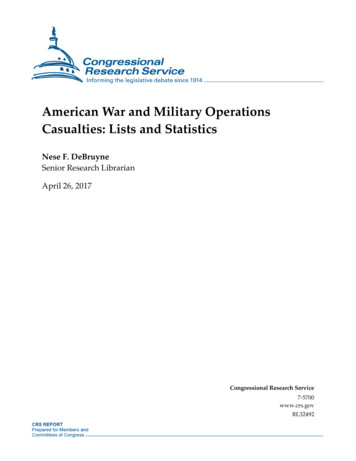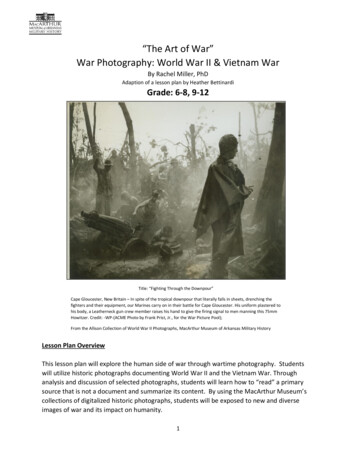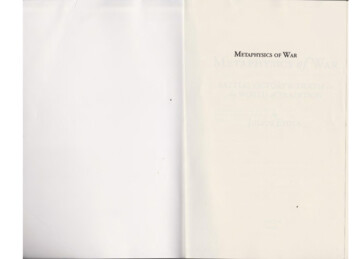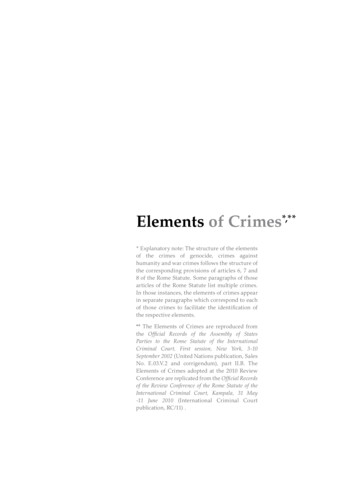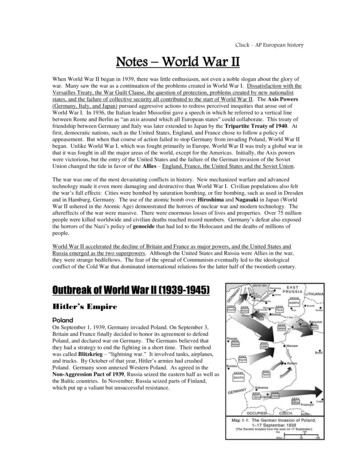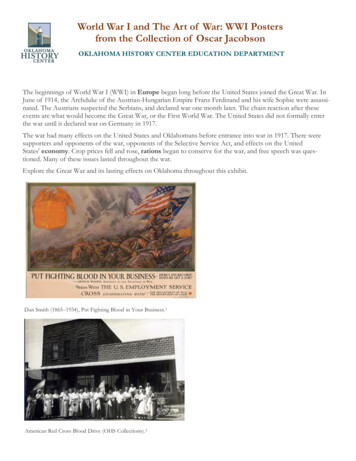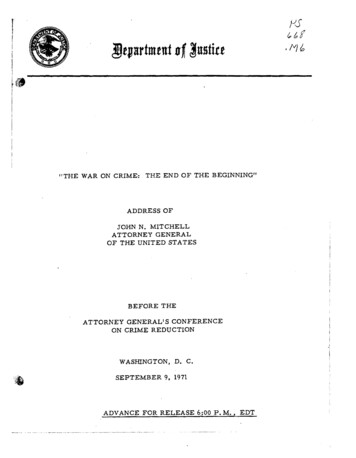
Transcription
"THE WAR ON CRIME: THE END OF THE BEGINNING"ADDRESS OFJOHN N. MITCHELLATTORNEY GENERALOF THE UNITED STATESBEFORE THEATTORNEY GENERALIS CONFERENCEON CRIME REDUCTIONWASIDNGTON, D. C SEPTEMBER 9, 1971ADVANCE FOR RELEASE 6:00 P. M., EDT
I want to add my welcome to those you have alreadyreceived at the opening of this conference. I am indeed pleasedwith the fine attendance at thisexecutives.important meeting of law enforcementI thank you for responding to my invitation, and I firmlybelieve that our labors here can produce new advances in the nation'swar on crime.I do not hesitate to use the termit is.Ilwar,rrfor that is exactly whatThere is nothing controversial about this war.of law, justice, honesty, and public safety.There is the sideAnd there is the side oflawlessness, dishonesty, human exploitation, and violence.I considerour meeting here in Washington a strategy conference on our side--aconference among allied officers over the maps of tomorrow l s battlefield.To continue the analogy, we meet at a critical point in thewar against crime.Through the decade of the 1960s the crime rate
in the United States soared.kept increasing.It not only increased, but the increaseIn the 10 years from 1960 to 1970, serious crime as:measured by the FBI Uniform Crime Index rose 176 percent.of our largest cities, including the capital of ournation In somethe streetsin the heart of the business district were considered by many to be unsafeat night.There was no blinking the fact that we' were beset by an alarmingcrime wave, and many Americans believed our society was beginning tocrack at the seams.I will not go into the reasons for this crime wave.Some saidthat fighting crime was a matter of social reform- -if we had a bettersociety free of social ills we would have less crime.In the long runthey had a point, but that was small comfort to last night's victim ofmugging on the city street.It was a little like sitting on a hillphilosophizing about erosion control while a flash flood is carryingaway y,?ur town.In 1968 Richard Nixon called for decisive action against thecrime wave in this country.He recognized that Federal jurisdictionis limited to Federal crimes, and that the first and main lines ofdefense against crime were the local and state peace officers.But he
also knew that law enforcement across the nation desperately needednational leadership and national example.When he was elected Pre sidenthe instituted a comprehensive drive against crime--a many-facetedprogram that marshalled every Federal enforcement arm.He alsoasked for and won a sharp acceleration in Federal financial aid to stateand local enforcement agencies.The nation suddenly found that it hadleadership in the war on crime.At the same time the local and state enforcement agencies acrosstne country were directing renewed efforts in the same war.Many ofthem applied added funds for better equipment, more manpower, bettertraining.More support has also come from the public and fromprivate groups, such as the U. S. Chamber of Commerce, which haspublished educational booklets about crime and has helped in other ways.Altogether, the nation renewed its attack on c rime.few who were sitting on. the hill philosophizing.There wereThere were more whowere in town throwing sandbags into the breach.Today we are seeing the first encouraging results of thismonumental effort by the nation's peace officers.Fear is beingswept from the streets of some . -though not all--American cities.the first quarter of 1971, as you know, 60 American cities showedIn
an actual decrease in the number of crimes.And while seriouscrime continued to increase in the nation as a whole, the rate ofincrease is finally slowing down.Only last week the FBI's annualUniform Crime Report for 19·70 confirmed this trend.In 1968 crimehad increased 17 percent over the previous year, 12 percent in 1969and 11 percent in 1970.Moreover, in the great cities of the country- those with 250, 000 or more people- - serious crime increased by 18percent in 1968, 9 percent in 1969 and 6 percent in 1970.Now I don't wish to make too much out of these figures.can take some encouragement, but not much comfort.WeWe have thetrend going in the right direction, but that trend is still too tentativeto let us shout very loud.To go back to my analogy, theadvance has been slowed, but he is not yet retreating.enemy sI'd like to thinkthe situation can be described in Winston Churchill's cautious wordswhen th.e Allies had stalled Nazi expansion and opened a new front inAfrica in the fall of 1942 .lINow this is not the end, " he said.of the end.HIt is not even the beginningBut it is, perhaps, the end of the beginning.tI
So this benchmark calls upon us to assess our strategy, toexchange our experiences in penetrating the enemy's vulnerable spots,to learn from each other's successes and failures.Here at thisconference we can redirect our forces and mount an even strongeroffensive against crime.In dOing so, I wish to emphasize that this conference is andmust be a mutual ex"change of ideas between all jurisdicti.ons.TheFederal Government is not here to dispense some higher wisdom, butto trade ideas with all the others on the firing line.We haveanticipated sharing the experience, for example, of the police chiefsfrom the 60 cities showing a reduction in crime.Each of us has hiscontribution to make, and I for one would like to share with you someof the reasons why, from the Federal viewpoint, I am encouraged inthis war on crime.First, 'we have legislative weapons that were not availablebefore.The Omnibus Crime Control and Safe Streets Act of 1968provided for, among other things, court-authorized wiretapping.While the previous Administration did not see fit to use this weaponthat Congress had given it, President Nixon sanctioned its use as one
of his first acts of office.Since then it has proved to be an extremelyeffective method of obtaining evidence in organized crime cases whereother methods are ineffective or too dangerous.In 1970, more thantwo out of every three messages intercepted by Federal investigatorswere incrimInating, and for every Federal wiretap there was anaverage of between three and four arrests.When PresIdent Nixon took office he called for other anti-crimelegislation, and most of it was passed by Congress.This includes theOrganized Crime Control Act of 1970, which provided better means ofenforcing laws and securing evidence in organized crime cases.Itincluded the Comprehensive Drug Abuse Prevention and Control Actof 1970',which provided stronger enforcement tools and penaltie sagainst drug traffickers.And it included the District of ColumbiaCourt Reform and Criminal Procedure Act of 1970, which has providedthetool for further reducing crime in the one major urban area entirelywithin the Federal jurisdiction.Without waiting for this legislation, President Nixon and hisAdministration took every step to escalate the war on crime.ThePresident established the National Council on Organized Crime, whichmobilized all appropriate Federal agency heads and the special expertise
of their staffs.I am able to report that the number of organized crimeand gambling figures convicted as .a result of FBI investigations hasrisen sharply--from 281 in fiscal 1968 to 631 in fiscal 1971.In the difficult area of narcotics control, the Federal Governmentprovided national leadershipAll appropriate Federal agencies haveincreased their arrests and confiscations.In perhaps the mostsignificant breakthrough in this field, the Turkish Government has agreedto halt its opium-growing industry.We all know that narcotics controlis a very persistent problem, but we also know that as we defeat it wewill bedefeati gan important cause of crime.The District of Columbia has been the scene of remarkableachievements.In fiscal 1971 the volume of crime in Washington, D. C.was 18. 7 percent lower than in fiscal 1970.in which crime dropped since1956.s chThat is the first fiscal yearrecords have been kept beginning inFigures have just been published showing a further decrease of10. 6 percent for the month of July compared to the previous July, whichin itself showed a decline over the same month in 1969.These Administration actions that I have just described havebeen confined to the limited area of Federal jurisdiction.I turn nowto the far broader area in which Federal support has had an impact onall jurisdictions, and with which you are more familiar.I refer to theLaw Enforcement Assistance Administration, which was created by
the Omnibus Crime Control and Safe Streets Act of 1968.At PresidentNixon's urging this agency's budget is now more than 10 times itsoriginal budget of three years ago.It grew from 63 million in fiscal1969 to a fisca11972 appropriation of almost 700 million.In the past three years, police programs have benefited eitherdirectly or indirectly from more than 370 million in LEAA funds.There are thousands of police programs under way in theUnited States which would not have begun--could not have been created- without LEAA funds.Partly because of the LEAA program there aremore policemen on the street, there are more patrol units, and betteritems of police equipment than there were three years ago.Police communications ar e being improved partly becauseLEAA has provided more than 38 million to finance better local andstate systems, control centers and much-needed equipment.Police ability to deal with bombings is being improved becauseLEAA has committed well over 2 million for special training of localand state officers, for bomb disposal research, and for technical aid.Graduates of LEAA' s bomb disposal course have paid it the supremecompliment, saying it has saved lives' and prevented injuries.
A number of LEAA programs are helping to improve policesafety- -and provide better equipment.Among these efforts was theIAcpr s bomb data center, and the testing of different police armor vestsby LEAA's new Law Enforcement StandaJ;"ds Laboratory.Take any area of the country and we see LEAA funds at workin important programs.As you know, there have been and are keyLEAA projects among those 60 cities which have recorded substantialcrime decreases during the first quarter of this year.One important activity, the Law Enforcement EducationalProgram, is very visible not only to you as police administrators,but to all members of police departments.To date, over 60,000police officers have received educational benefits to help them in theirprofessionalization.All of this, coupled with the other avenues of Federal actionthat I mentioned, gives me a positive feeling about the national war oncrime.againstMany of these innovations, such as the new enforcement weaponsorgan zedcrime and some of the significant LEAA projects,are young programs.We have only partially seen their effects.they gather momentum I believe we will see more crippling blowsagainst the enemy.As
It is true that not all the results are going in our favor.number of police killings each year is still on the increase.aboIll:inable and shocking trend must be reversed.TheThisAlthough federaljurisdiction in this area is limited, President Nixon has directed theFBI to join nthe investigation of a police killing when asked to do soby the local authority.Equally important, all federal investigativeagencies are on notice to share immediately with state or local policeany information they receive about possible police killings.In addition,the President has proposed legislation to Congress to assist thefamilie s of office rs killed in the line of duty.The number of police murders reminds us very forcibly that thewar against crime is far from over.We have by no means reached thebeginning of the end, but 1 believe we are at the end of the beginning.We have mobilized our resources.We have established communicationsand strategic links between our various commands.And in my opinion,most important of all, 'we have strong national leadership.We havea President who has gone on record in no uncertain terms in supportof the law enforcer.Only a few weeks ago he summarized thesituation when he told a gathering of local peace officers:When you go home, tell your colleagues that the eraof permissiveness with regard to law enforcement isat an end in the United States of America. Tell your
colleagues that in terms of support of the Presidentof the United States and the Attorney General, we backlaw enforcement officials in their attempts to reestablishrespect for law, in their attempts to enforce the lawwith justice.Gentlemen that statement sums up the present situation.climate for decisive inroads against crime was never better.TheWe havethe resources, the capabilities, the support of the public, the leadershipof the President.Here at this conference we have the ability tomarshal these assets even more effectively to assure the peace andsafety of American society.
JOHN N. MITCHELL ATTORNEY GENERAL OF THE UNITED STATES BEFORE THE ATTORNEY GENERALIS CONFERENCE ON CRIME REDUCTION . Address of John N. Mitchell, Attorney General of the United States, Before the Attorney General's Conference onb Crime Reduction, Washington, D.C., September 9, 1971 (Advance for Release 6:00 P.M., EDT) .



